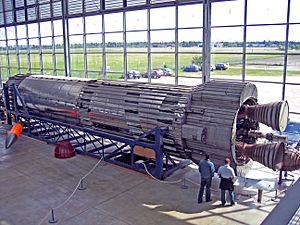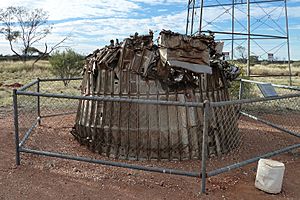Blue Streak (missile) facts for kids

Blue Streak at the Deutsches Museum, Schleissheim, Munich
|
|
| Function | Nuclear strike, satellite vehicle |
|---|---|
| Manufacturer | de Havilland Propellers, Hawker Siddeley Dynamics , Raytheon, Hallicrafters (maintenance and technical support) |
| Country of origin | UK |
| Size | |
| Height | 80 feet (24 m) |
| Launch history | |
| Status | Retired since 1971 |
| Launch sites |
|
| First flight | 5 June 1964 |
| Last flight | 5 November 1971 |
| stage | |
| Engines | Rolls-Royce RZ.2 |
| Fuel | liquid oxygen/kerosene |
The Blue Streak was a large British rocket. It was first designed to be a powerful missile, but it was later used as the first part of a satellite launcher called Europa. The Blue Streak project was eventually stopped before it was fully ready for use.
Britain wanted its own way to deliver nuclear weapons, so it started the Blue Streak project in 1955. The design was finished by 1957. However, the missile system became very expensive. It was also thought to be too easy to attack by surprise. Because of these reasons, the missile project was cancelled in 1960. The UK then planned to use American missiles instead.
To avoid wasting all the money spent, the UK government suggested using Blue Streak as the first stage of a civilian satellite launcher. This project was first called Black Prince. Since it was too costly for the UK alone, other countries were asked to help. This led to the creation of the European Launcher Development Organisation (ELDO). Blue Streak became the first stage of their rocket, named Europa.
Europa was tested in Woomera Test Range, Australia, and later at Kourou in French Guiana. After several failed launches, the ELDO project was cancelled in 1972. This also meant the end for Blue Streak.
Contents
Why the Blue Streak Rocket Was Needed
After World War II, Britain's nuclear weapons were mostly bombs dropped from planes called V bombers. But it soon became clear that Britain needed ballistic missiles to have a strong nuclear deterrent. A deterrent is something that stops an enemy from attacking. Britain wanted its own independent deterrent to remain a major world power. It couldn't just buy American weapons because of certain laws.
In 1954, the United States suggested working together on missiles. The US would develop a very long-range missile, and the UK would develop a medium-range missile with US help. Britain agreed to this plan. The goal was to learn more about missile design from the US. The Royal Aircraft Establishment and the Rocket Propulsion Establishment helped set the early requirements for the rocket.
Building the Blue Streak Rocket
The company de Havilland Propellers won the job to build the Blue Streak missile. It was powered by a strong engine called RZ.2, made by Rolls-Royce. This engine could move its direction slightly during flight to steer the missile. This steering was tricky because the rocket got lighter very quickly as it used up fuel.
Other companies also helped. Sperry Gyroscope Company made the guidance system that helped the missile fly straight. The Atomic Weapons Research Establishment designed the nuclear warhead, which is the part that carries the nuclear weapon.
The missiles used liquid oxygen and kerosene as fuel. While kerosene could be stored in the rocket for a long time, the liquid oxygen had to be loaded just before launch. This took about 4.5 minutes. This meant the missile couldn't be launched very quickly if there was a sudden attack.
To protect the missiles from a surprise attack while they were being fueled, engineers thought of putting them in underground launchers, called silos. These silos were designed to protect the missiles from a large explosion nearby. Building these underground sites was very difficult. RAF Spadeadam in England was the only place where a full-scale underground launcher was started. This site was also used to test the RZ.2 engines and the complete Blue Streak missile.
In 1955–1956, the rocket engines were tested on the Isle of Wight. Since Britain didn't have enough space for full test flights, a special test site was set up in Woomera, South Australia.
Stopping the Military Project
The cost of the Blue Streak project kept growing. It started at £50 million in 1955 and reached £300 million by 1959. Some people in the government felt the project was too slow compared to what the US and the Soviet Union were doing.
The project was suddenly cancelled in April 1960. The main reason given was that it would be too easy for an enemy to destroy the missiles in a first attack. Lord Mountbatten, a high-ranking naval officer, strongly argued that the project should be stopped.
After Blue Streak was cancelled, Britain decided to get the Polaris system from the Americans. These missiles were carried in submarines built by Britain.
Blue Streak's Civilian Life: Black Prince and ELDO
Even though Blue Streak was cancelled as a military missile, there was a lot of money already spent. So, people didn't want to just throw it all away. Blue Streak was then planned to be the first part of an all-British satellite launcher called "Black Prince". The second part would come from another British test rocket called Black Knight.
However, the Black Prince project was also too expensive for the UK to build alone. This led to the creation of the European Launcher Development Organisation (ELDO). This organization used Blue Streak as its first stage. France provided the second stage, and Germany provided the third.
European Launcher Development Organisation
The UK suggested working with other European countries to build a three-stage rocket. This rocket would be able to put a one-ton satellite into low Earth orbit. The European Launcher Development Organisation included Belgium, Britain, France, West Germany, Italy, and the Netherlands. Australia was also involved as a partner.
Work on ELDO started in 1962, and the organization officially began in 1964. With Blue Streak, the UK provided the first stage of this European rocket. France provided the second stage, and Germany provided the third. Italy worked on the satellite itself, while the Netherlands and Belgium focused on tracking systems. Australia provided the launch site.
The combined rocket was named Europa. There were ten test launches. The Woomera launch site was not good for putting satellites into a special orbit called geosynchronous orbit. So, in 1966, it was decided to move to the French site of Kourou in South America. The last Europa launch from Kourou in November 1971 failed. A review of the project led to the decision to stop the Europa design.
ELDO later joined with another organization to form the European Space Agency, which is still active today.
Key Europa Rocket Launches with Blue Streak
The Blue Streak first stage was generally successful in its ELDO test flights. However, problems often occurred with the French second stage or German third stage.
- June 5, 1964 (F1): First launch, successful for Blue Streak, but had some wobbling.
- October 21, 1964 (F2): Successful flight.
- March 23, 1965 (F3): Successful flight.
- May 24, 1966 (F4): Successful flight.
- November 15, 1966 (F5): Successful flight.
- June 4, 1967 (F6.1): Second stage failed to light up.
- December 6, 1967 (F6.2): Second stage failed to separate.
- November 29, 1968 (F7): Third stage failed after separating.
- July 3, 1969 (F8): Third stage failed after separating.
- June 24, 1970 (F9): The nose cone (fairing) failed to separate.
- November 5, 1971 (F11): The guidance system failed, causing the rocket to break apart.
Blue Streak Today
After the Blue Streak project was cancelled, some of the remaining rockets were saved and put on display. You can see parts of Blue Streak at:
- The National Space Centre in Leicester, England.
- The Deutsches Museum near Munich, Germany.
- The National Museum of Flight in East Fortune, Scotland.
- The Euro Space Center in Redu, Belgium.
- RAF Spadeadam in England, where you can see parts of the outer shell and launch sites.
You can also find RZ.2 engines at the National Space Centre, the Armagh Planetarium in Northern Ireland, and the Euro Space Center.
A piece of the Blue Streak rocket launched on June 5, 1964, was found in Australia in 1980. It is now on display at the Giles Weather Station.
Blue Streak launches have even appeared in movies and TV shows! Footage was used in the TV series The Prisoner and Doctor Who. Images of Blue Streak were also in the 1997 film Contact.
See also
- Black Arrow
- Black Knight
- Nuclear weapons and the United Kingdom


